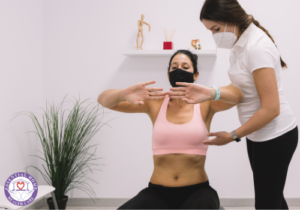These stroke-recovery hand exercises may help you enhance your fine motor abilities. For the best outcomes, it’s critical to engage in some type of hand therapy on a daily basis. Basically, there’re many occupational therapy exercises for stroke patients you only need to follow them for the best results.

Several Stroke-Related Rehabilitative Hand Exercises:
- High repetition is the goal when practicing hand exercises. This serves to excite the brain while also promoting neuroplasticity.
- The process through which the brain rewires itself and recovers from harm is known as neuroplasticity. “Re-wire to re-fire,” as the saying goes.
- When you perform an action on a regular basis, such as these hand exercises, the brain builds and strengthens neural connections, making the movement easier in the future.
- The stimulation causes the brain to respond. When you do hand exercises every day, your brain learns that hand function is crucial. The brain strengthens the circuits that control hand function in response.
Level 1: Stroke Patients’ Gentle Hand Exercises
Level 1 hand exercises are a wonderful place to start if you have limited hand movement or paralysis. These exercises can be done in a passive manner by assisting your affected hand using your non-affected hand. Despite the fact that your non-affected arm is “doing the work,” passive exercise stimulates neuroplasticity. For the finest outcomes, you must be consistent. However, contact us for an occupational therapist in Chicago or you can also call us.
Here are some simple hand exercises that you can do at home:
1. Raise and Lower Your Hands
- Occupational therapist on the table, palm down
- Hand rehabilitation by OT with palm up on the table
- Place your hand palm-down on a table for this therapeutic hand workout. Turn your palm up with your non-affected hand. Rep with your palms up and down.
2. Wrist Bending Movement
- therapist extends her hand in front of her
- therapist bends her wrist backward gently
- Bring mobility to the wrist for the next exercise.
- Place your non-affected hand on the palm rather than the fingers to stretch your affected hand at the wrist while keeping your elbow on the table.
- Stretch backward and forwards, then backward and forwards again. Slowly and in a pain-free range, perform this action.
3. Wrist Movement on One Side
- With the right hand on top, place your left-hand palm-down on the table.
- The left hand is gently pushed sideways by the right hand.
- For stroke victims, this is the final level 1 hand exercise. It allows the wrist to move in a separate direction, from side to side.
- Place your affected hand, palm down, on the table. Then slide your hand to the left, then to the right, using your non-affected hand. Side to side, gently repeat.
- These hand exercises should be done on a daily basis with a lot of repetitions. The best technique to retrain the brain and enhance movement after a stroke is to exercise in large groups.
Stroke Patients at Level 2: Moderate Hand Exercises
The hand exercises below are designed for people who have mild spasticity and limited hand movement. The key to regaining movement in your hand is to do these hand exercises on a daily basis. To see results, you must be consistent.
For stroke sufferers, here are some more therapeutic hand exercises:
The Rolling Motion
- therapist exercises with a water bottle in hand
- the therapist holds a water bottle in his hand, squeezing it.
- Place a water bottle in your affected hand for this slightly advanced hand workout. Maintain a comfortable grip on your hand and fingers.
- Curl your fingers around the water bottle you’re holding. Then slowly lower yourself. Continue the movement by slowly opening and closing your fingers, giving your brain time to detect and retrain the motion.
- This hand exercise isolates the wrist muscles and is a strength-building exercise.
Wrist Curl
- An occupational therapist demonstrates a hand exercise.
- a therapist using a dumbbell-like water bottle
- This workout is similar to a bicep curl, but it is done using your wrist.
- Hold the water bottle in your affected hand and support your arm with your non-affected hand. Curl your wrist up after allowing it to stretch down. Slowly repeat up and down.
Grip and Let Go
- A physical therapist demonstrates a hand workout for stroke victims.
- For hand exercise, the therapist moves the pen across the table.
- Ultimate posture for stroke patients’ hand exercises
This is the final level 2 hand exercise
On one side of the table, place a pen. With your injured fingers, grasp it as tightly as possible. Release the pen after sliding it across the surface. Concentrate on softly grasping the pen. To emphasize the therapeutic value of this exercise, move the pen with the least amount of power possible. Rep by sliding the pen back over the table while maintaining your forearm pressed against it. This eliminates the need to use your shoulder to finish the movement (known as synergistic movement).
Only do the exercises that are difficult, not those that are frustrating. If you can’t do it right the first time, try again in a few weeks.
Stroke Patients’ Challenging Hand Exercises
- The hand exercises below are for stroke patients who have some dexterity and movement in their hands but want to enhance fine motor skills.
- Spin the Pen
- On a table, a therapist spins a pen.
- Hand exercises for stroke victims are demonstrated by a therapist.
- Place the pen on the table and spin it with your thumb and fingers for this advanced hand workout. To avoid using your shoulder during this action, rest your elbow on the table. Isolate your thumb and fingers as much as possible. This practice will put you to the test in terms of speed. For 15 seconds, spin the pen quickly in one direction or in the opposite direction.
Coin Toss
- quarters in the palm of the therapist’s hand
- Pinching a quarter between the thumb and index finger of the therapist
- For hand therapy, the therapist places a quarter on the table.
- There are three motions in this advanced hand workout. Place 8 quarters in a row in the palm of your affected hand to begin.
- To hold with your index finger and thumb, move your thumb one-quarter of a turn. Then, using your other fingers, place the quarter on the table while maintaining the other quarters in your palm. Hand manipulation and translation talents are what this is referred to as.
- Because it demands synchronization of all five fingers, this is a difficult hand workout. Reverse the exercise to pick them up when you’ve finished placing them down individually.
Curl your Fingers
- For hand exercise, an occupational therapist touches the thumb to the index fingertip.
- For advanced hand exercises, the therapist touches the thumb to the ring finger.
- Try to touch each fingertip to your thumb in this final hand exercise. Starting with your index finger, pinch and release your middle finger, then your ring finger, and finally your little finger.
- This is the same motion used in MusicGlove hand therapy, rehabilitation equipment that allows you to work out while playing a musical game. It’s been clinically demonstrated to assist stroke victims to improve hand function in as little as two weeks.
- That’s all there is to it! We hope that these hand exercises will be beneficial to you during your recuperation.
Essential Home Health Care is well known for occupational therapists Chicago. Are you wondering to know about occupational therapy for carpal tunnel? Read our post and get benefits from this. To take more information about it, you can call us at (847) 813 6301.
